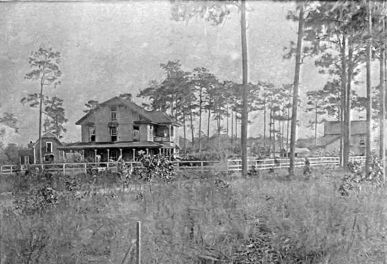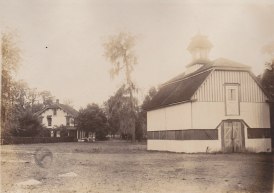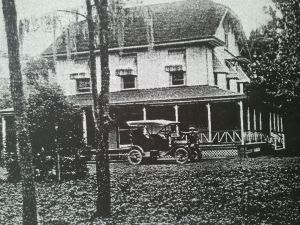There is a mystery I can’t seem to solve, even when searching through the myriad of Lake County deeds. It involves the compound, the Zephyr Lake site of Stapylton and Company and my propensity to wanting to know the details. Here’s the scenario:
1885 The Stapylton’s dined at the big house belonging to Staplyton and Company (Stapylton, Budd, Hereford who sold it to Stapylton 11/19/1885).
July 1886 Holy Trinity Episcopal Church’s organizational meeting at Stapylton’s Dining Hall.
December 1888 deed abstract for 1.35 acres on which is penciled “Hall and old GCS home.” This acreage was sold to Arthur Halford (1896)<Ida Prall (1905)<Ninian Lindsay (1906);<R.F.E. Cooke and inherited by his wife Margaret<Lola Gorman (1943)<Pringle and Turner (1943).
1889 picture of Stapylton & Co., caption on which notes: L-R stables, boarding house, kitchen with dining room. Smaller buildings appear between. A trail runs along the fence line. Note the leaning pine tree evident between the stable and boarding house. Looks to have been taken from the southwest corner. The boarding house is close to the fence line perhaps indicating the western boundary of Stapylton’s property.
July 1889 Reception after the consecration of Holy Trinity church held at Stapylton and Budd’s Hall.
1890s Stapylton sold most of his remaining land in Section 4 to R. F. E. Cooke. In the 1920s Cooke built his home, Franmar, on the 1.35 acres.
Pictures taken when plantings matured show the stable in foreground, the east side of boarding house with awnings over the windows and the leaning, spindly pine tree between the two structures as in picture taken in 1889.
~1915 Picture of “The Hall” (same as below) that looks exactly like the boarding house! Were they replicas?
1924 Lillian Vickers-Smith, “History of Fruitland Park,” writes about the English Colony, “For them Zephyr Hall, familiarly known as ‘The Hall,’ was built as a boarding house.” The accompanying picture is labeled Zephyr Hall. Windows have awnings; no visible plantings around foundation.
The 1930 US census for Lake County and specifically for R. F. E. Cooke of Franmar shows that Harriet Deal, the mother of his first wife, Ada, lived next door. Is the boarding house aka The Hall?
December 1946 Pringle and Turner subdivided what was essentially Stapylton’s original land on Zephyr Lake into a subdivision, Zephyr Lake. The main buildings, stable, boarding house and dining hall, would now become Lots 1 and 2.
1951 Pringle and Turner to Wilkens & Margaret Lenhart, Lot 1 (site of Staplyton’s old home, residences of R. F. E. Cooke (Franmar), and currently Michael Coons.
1952 Pringle and Turner to Albert and Dorothy Turley, Lot 2 site of “The Hall.” (Margaret Lenhart and Dorothy Turley were sisters.)
1971 (undated Leesburg Commercial article “When the English Roamed the Hall” by Norma Hendricks.) Claims Cooke lived at The Hall until Franmar completed. Now an apartment building with six units owned by Albert and Dorothy Turley. Maybe Cooke had the boarding house demolished when building his new home.
1990s Betty Coons inherits both Lots 1 and 2.
1996 Betty Coons sells Lot 2 to John H. Connell who currently owns the Zephyr Lake Tree Farm located thereon.
2001 Fruitland Park publishes “The Beginning of a New Era” that includes a picture of “The Hall” and cites that “a large boarding house was built on the lakeshore and named “Zephyr Hall.” Picture taken about 1915 labeled “The Hall.” This is the same picture as in the Vickers-Smith book and above.
The 1889 picture and the 1971 picture look exactly the same. Mike Coons remembers well The Hall next door that his great-aunt operated as a bed and breakfast.


